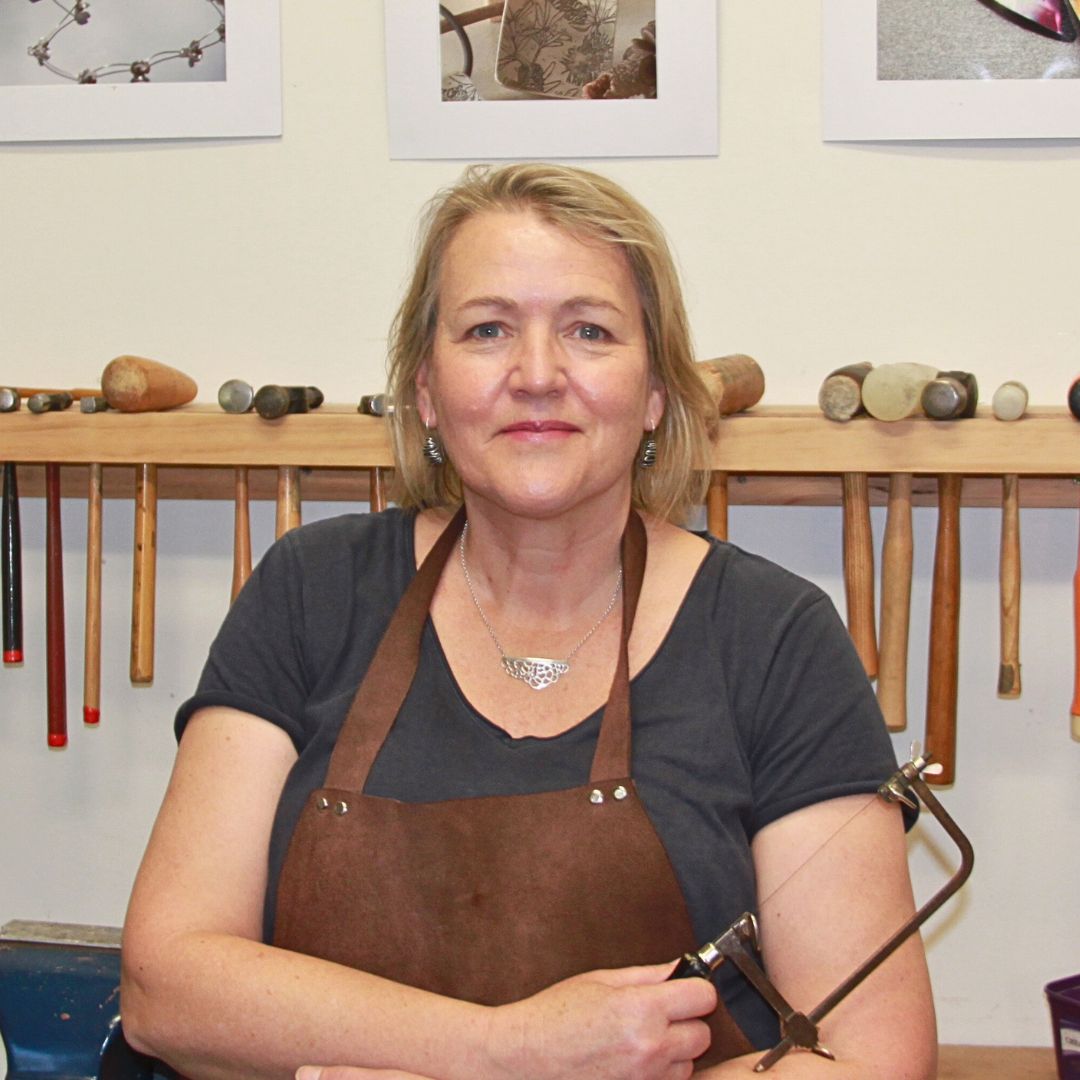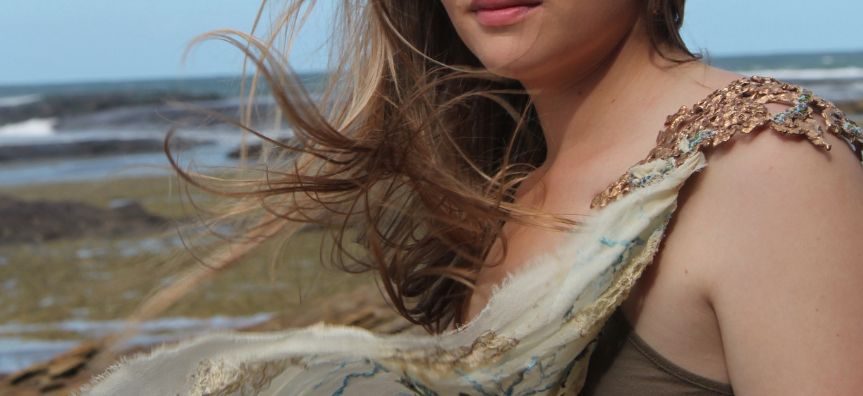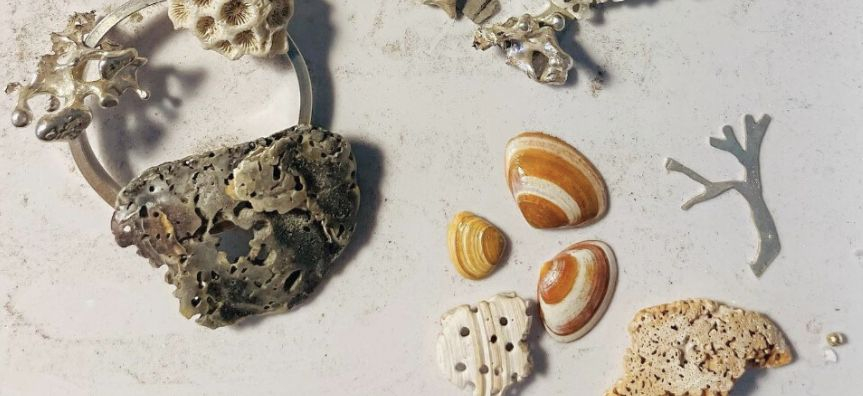
Susan is a jewellery and print designer/maker based on Sydney’s Northern Beaches. Having studied Fine Art at University of Sydney, and Master of Art Administration at UNSW, she went on to work in the museum industry in Australia and the USA.
She began her journey with metal in 1991, mentored by renowned Australian silversmith, Valerie Aked. Currently working out of Silver Plus Studio, a member-run collective studio space, she exhibits her work regularly at independent studios and as a member of the Pittwater Artists Trail.
With collaborator Christine Sadler, her work was shortlisted as a finalist in the Contemporary Wearables Biennial, Jewellery Award (2023); Northern Beaches Environmental Art and Design Prize (2022, 2024); Meroogal Women’s Art Prize (2022); and Greenway Art Prize (2022).
We believe you have an obsession with Caddy Spoons. Can you tell us about this, starting with, what is a caddy spoon?
Well, it’s more an obsession with handmade spoons in general - but with caddy spoons it is because I like the idea that one can bring beauty to and enjoy everyday objects. The caddy spoon is the spoon that lives inside the Tea Caddy or box storing the dry leaves, and is used to scoop tea into the pot in measured amounts – one for each person and one for the pot! This humble daily ritual is deserving of a beautiful scoop. It’s one of the first things I see each and every day, and it reminds me to enjoy the little things in life.
Do you have other obsessions that show up in your work?
Yes, pebbles, shells and the honeycomb rocks you see on the Northern beaches rock shelves. I can’t go for a walk along the beach or rockshelf without returning home with a pocketful of interesting bits and pieces. I love the water-worn textures, the intricate designs on a shell. Seaweed and seagrass is also a recurring theme, in the past more influenced by the cut-out designs of Matisse, but more recently working directly with dried pieces of seaweed or attempting to mimic the movement of seagrass underwater. My pieces ALWAYS have a story to them, which I attempt to express through the piece.
What is the first object you remember making with silver, and what do you love about working with metal?
My very first piece was a ball made from two flat discs of silver about the size of a 20cent piece. It was an exercise that taught me many of the basic skills in working with metal. Saw out the discs; file the edges even and smooth; anneal and dome both into semi-spheres. I then had to solder them together and end up with a lovely ball which I incorporated into a brooch. I still have it.
What fascinates me about metal is how this seemingly hard surface can be moved and manipulated in so many ways. You learn to understand the forces required to curve and twist the metal into your desired shape. It is so versatile – you can polish it to a high gleam, or finish it with a patina. It can be textured with a hammer; melted and moulded; or rolled through a mill to take up the texture of a delicate leaf or a paper stencil. I enjoy working with my hands, and seeing that metamorphosis from flat sheet to a bright 3D object.
You’ve said that “it’s all about the shoreline this year for me”. Why is that connection important to you this year?
The coastal environment in which I live has always been important to me, and reflected in my work, but this year I took that interest INTO the environment itself rather than responding to it. This came about through my collaborative work with Christine Sadler. In January we took our tools, handheld blowtorch and metal sheets down to the rockshelf and experimented with the textures and shapes we could achieve using the ridges and dips in the rocks themselves. I also tried out other ways of recording the surface of the rocks using silicon putty. We got some really interesting results. I have been working with the resulting barnacles and rock surface pieces throughout the year, and used them for several new works including the piece Belgoola – Swirling Waters which was a finalist in the Environmental Art and Design Prize 2024.
You’re involved in a couple creative communities in the Northern Beaches, the shared workspace at Silver Plus Studio, and the long-running Pittwater Artists Trail.
How does working with these groups of people influence or inform your work? Further, what do you think people need to consider before committing to a shared studio space or an artist collective?
Being a part of Silver Plus Studio has been hugely informative and supportive. Each member has their own style and interests, but it is so helpful to have someone else to ask when you are struggling with a design, or want to learn a new skill to include in your work. We are not all there at the same time, so I often don’t see others work until we have a studio exhibition, and I am always thrilled to see the range and skill displayed by my colleagues. It is so important to me to be a part of a community of makers who are as interested in metalwork as I am. And, by sharing the studio space I have access to a lot of equipment I could not hope to afford on my own. This alone makes it a worthwhile exercise before even tapping into the social benefit.
Similarly the Pittwater Artists Trail reminds me that there is a huge network of creatives out there and one is not alone. I love seeing the breadth of work that the trail members create, and it feels reassuring to be a part of a supportive and positive creative community.
In consideration of committing to a shared studio space or collective, I think you need to be ready to put your hand up to contribute to the day to day upkeep and maintenance of the space. Remember that you are one part of a whole. Be open to some personal eccentricities and idiosyncracies and respond with grace and patience. Never expect anyone to do anything you wouldn’t be willing to do yourself, nor assume that someone else is going to do that thing that needs to be done.
Within those bigger communities, you have found repeat collaborators like Christine Sadler.
What’s the secret to a successful collaboration?
Christine and I shared studio time at Silver Plus for several years and often found that our influences and preoccupations overlapped. I think we have a pretty good understanding of each others interests and skills. We agreed to collaborate on special pieces in 2022, playing to our strengths. Christine is a better planner than me, she keeps me on track. I am the wordsmith responsible for conveying our concept into written form.
We have found that the act of collaborating has forced us to clearly define and articulate our ideas from the outset, and clearly divide responsibilities for the execution of parts of the design. Involving two perspectives in a project enables us to deepen the experience of conceptual development and problem solving while making the work. I think the secret of a successful collaboration is to be willing to listen to your partners ideas and be open to change. We actively learn from each other, and enjoy sharing updates on our research and progress of the project itself.
You’ve entered and been successful in several art prizes. For example, Contemporary Wearables 23: Biennial Jewellery Award (2023); Meroogal Women’s Art Prize (2022); Greenway Art Prize (2022); and of course, the Northern Beaches Environmental Art and Design Prize (2022 & 2024).
Why do you enter prizes? How does it help your career and your practice?
I enter prizes because it is a way of seeing my work and ideas within a broader context and finding a new audience. I’ve got some pieces going off to the JMGA National Prize in Perth in October, and am presently working on this years entry for the Meroogal Women’s Art Prize in Nowra. It’s really satisfying to know that my work is being seen in Queensland or Western Australia, or even in different parts of Sydney and NSW not only by members of the public but also by my peers. Many prizes also have a theme or directive which challenge me to explore themes I might not normally choose. It is good to get out of your comfort zone sometimes.
Speaking of prizes, we love your work in the current Environmental Art & Design Prize exhibition. You’ve said your work, Belgoola – Swirling Waters, evolved from experimentation on the Bilgola rock platform and working with the landscape.
Can you describe how you worked with the environment to create this piece? And can you describe the story of this piece, and how you worked with the environment to create it?
The name of the piece is in recognition of the traditional owners of the area around Bilgola and (according to the council website) is a loose translation of its meaning which seemed perfect to express the energy of the sea and wind on the rockshelf. The work evolved from the experimentation we started in January on the Bilgola rock platform. We wanted to make something that was OF that landscape, and where the body itself BECAME the landscape upon which the piece sat. I took a direct cast of my favourite honeycomb rock surface. Christine dipped delicate silk georgette in the saltwater pools and hammered it against the seaweed.
Back at the studio I poured wax into the mould and cut out, filed and sanded my desired shape. I then took it to my trusted refiner, Alexander Cooke at Australian Refiners in Warriewood, who suggested I cast it in bronze. It was so large, that it had to be cast in three pieces and soldered back together afterward. Once done, I forged the piece to fit the shoulder of the wearer. To meld the two textures - the fabric and the surface of the metal - Christine embellished the silk by hand with thousands of tiny French knots emulating the encrustations of the rock platform environment, continuing some stitches up onto the metal surface itself.
You’ve transformed organic materials like seaweed and shells into metal jewellery, wearable art and serving ware. We imagine these can be delicate and difficult materials to work with. On the flip side, it seems like metalwork involves robust materials and industrial processes. For example, you created a spoon from kelp foraged on Bilgola Beach, and earrings from shells found on a washed up.
How do you work with these seemingly opposite materials? What does the casting process look like? (if you’re able to give away your trade secrets!) Also, how do you choose the ‘right’ piece of seaweed to cast?
How do I work with seemingly opposite materials? Boundless optimism and fantastic industry support. In my creative practice I sometimes think it is better that I don’t know the ‘rules’ of a trade jeweller. I come up with an idea and then force the materials to do my bidding. Mind you – it doesn’t always work out!
The olive spoon I made from foraged kelp was something I had in mind for a long time. It was indeed a very floppy piece of seaweed, but I really liked its texture and branches. After it had dried, I took it to the Refiners and said “Crazy Lady Question – do you think I could make this a spoon handle?”. Instead of chucking me out he suggested I add some wax to some of the thinner areas to bulk it up, so I did. He later told me he was absolutely stunned when I returned with my piece ready to go. It was extremely difficult for him to set the cast – it is really more a piece of sculpture than a spoon - but we got there. My vision could not have been achieved without his expertise, and it is nice when someone ‘gets you’. I’m absolutely thrilled with the final piece, and plan a limited edition of 10. Two have already sold.
Along with individual pieces, you’ve produced series of work like the Fragments series and Backyard Natives series.
What are the benefits of working in a series? Do you start out with a plan, or does the series evolve? At the other end, how do you decide if a series is finished?
Working in a series allows you to more fully explore a concept, and the individual pieces expand into a conceptual whole. I don’t generally set out to produce a series but usually one thing leads to another. The Backyard Natives for example came from a desire to explore etching as a technique in my silver. It was a COVID lockdown project, so I had LOTS of time to spin off ideas. I took photos of native plants in my garden and using design software turned them into black and white negatives which I could transfer to the surface of my metal. From a design point of view I wanted more than just flat metal with an image. The resulting pieces are clearly related as etched metal, but explore different shapes and combinations.
Fragments is a new series I am still working on. It features beautiful shell fragments scooped up from the ocean floor and blasted out with the sand onto a beach in North Carolina during a beach nourishment operation. The breakdown of the shell surface or sandblasted edges create gorgeous texture which I really want to highlight as the hero of these pieces.
You once created a memento mori (something which acts as a reminder of the inevitability of death). You made pieces of jewellery for three sisters, crafted from their deceased mother’s candlestick. This was a profoundly beautiful work.
Thank you, it is not something I usually do but felt it was a really important thing to do for my friend and her family. While they were cleaning out their mother's home they came across the candlestick. It had been broken. My friend offered it to me to melt down and use as raw material which was a really generous gesture. I decided that I could also do something for them in return. As I knew them all so well, I wanted to make something which reflected each of their personalities and tastes, yet retain something of the original designs embossed into the surface of the candlestick. I hope it evokes a happy memory of their lovely mum whenever they wear the pieces.
You’ve also used the phrase ‘future heirlooms’ when describing your work. These ideas speak to the longevity of the material you work with and the personal nature of your work.
What is your hope for pieces you make, and how does this influence your design and making process?
As makers we put a great deal of thought into creating a new object, and wrap that object in layers of our own creative narrative. We might initially be inspired by a texture, an experience, a memory - we then apply artistic expression and draw on our imagination to express meaning. I believe that it is inherent upon us as makers to require people to use their own thoughts and ideas when they interact with our work. Of course we want them to appreciate our ingenious ideas and styles of presentation, but we also need to ask them what it is that draws them to the piece and help to start to build the personal narrative with them.
I use the phrase “future heirlooms” as I hope that the new owner instills as much personal value into the piece as I did in its making. I like to consider - What was the reason behind their purchase? Did it remind them of a person, place or time? Did the piece invoke a sensory memory?
For example, earlier we spoke about my Seaweed Olive Spoon. A customer purchased one after talking with me about its origins. She said “I love that you foraged the seaweed from Bilgola Beach. My mother grew up there, and she told me so many stories. She is in a nursing home now, and I am going to give this to her to bring back all those memories”. THAT is a future heirloom, and it fills me with delight!





